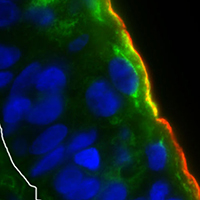Combined lectin- and immuno-histochemistry (CLIH) for applications in cell biology and cancer diagnosis: Analysis of human urothelial carcinomas

Submitted: 30 April 2020
Accepted: 10 June 2020
Published: 1 July 2020
Accepted: 10 June 2020
Abstract Views: 849
PDF: 589
Supplementary: 0
HTML: 4
Supplementary: 0
HTML: 4
Publisher's note
All claims expressed in this article are solely those of the authors and do not necessarily represent those of their affiliated organizations, or those of the publisher, the editors and the reviewers. Any product that may be evaluated in this article or claim that may be made by its manufacturer is not guaranteed or endorsed by the publisher.
All claims expressed in this article are solely those of the authors and do not necessarily represent those of their affiliated organizations, or those of the publisher, the editors and the reviewers. Any product that may be evaluated in this article or claim that may be made by its manufacturer is not guaranteed or endorsed by the publisher.
Similar Articles
- L. Pilloni, C. Manieli, G. Senes, D. Ribuffo, G. Faa, Merkel cell carcinoma with an unusual immunohistochemical profile , European Journal of Histochemistry: Vol. 53 No. 4 (2009)
- A Licata, A Mauceri, L Ainis, S Martella, MB Ricca, P Licata, A Amato, Lectin histochemistry of epidermal glandular cells in the earthworm Lumbricus terrestris (Annelida Oligochaeta) , European Journal of Histochemistry: Vol. 46 No. 2 (2002)
- Jindong Li, Jie Kang, Weiyan Liu, Jiazhe Liu, Gaofeng Pan, Anwei Mao, Qing Zhang, Jingfeng Lu, Junbin Ding, Hongchang Li, Docetaxel-resistant triple-negative breast cancer cell-derived exosomal lncRNA LINC00667 reduces the chemosensitivity of breast cancer cells to docetaxel via targeting miR-200b-3p/Bcl-2 axis , European Journal of Histochemistry: Vol. 66 No. 4 (2022)
- M.G. Bottone, G. Santin, C. Soldani, P. Veneroni, A.I. Scovassi, C. Alpini, Intracellular distribution of Tankyrases as detected by multicolor immunofluorescence techniques , European Journal of Histochemistry: Vol. 56 No. 1 (2012)
- A. Kovsca Janjatovic, H. Valpotic, D. Kezic, G. Lacković, G. Gregorovic, S. Sladoljev, G. Mršić, M. Popovic, I. Valpotic, Secretion of immunomodulating neuropeptides (VIP, SP) and nitric oxide synthase in porcine small intestine during postnatal development , European Journal of Histochemistry: Vol. 56 No. 3 (2012)
- S. Tetè, R. Vinci, V.L. Zizzari, S. Zara, V. La Scala, A. Cataldi, E. Gherlone, A. Piattelli, Maxillary sinus augmentation procedures through equine-derived biomaterial or calvaria autologous bone: immunohistochemical evaluation of OPG/RANKL in humans , European Journal of Histochemistry: Vol. 57 No. 1 (2013)
- Guest Editors, Proceedings of the 35th National Congress of the Italian Society of Histochemistry , European Journal of Histochemistry: Vol. 57 No. s1 (2013): Proceedings of the 35th National Congress of the Italian Society of Histochemistry
- K Hirai, M Kumakiri, K Ueda, Y Imamura, S Noriki, Y Nishi, H Kato, M Fukuda, Clonal evolution and progression of 20-methylcholanthrene-induced squamous cell carcinoma of mouse epidermis as revealed by DNA instability and other malignancy markers , European Journal of Histochemistry: Vol. 45 No. 4 (2001)
- CarloAlberto Redi, Signal transduction immunohistochemistry - Methods and protocols , European Journal of Histochemistry: Vol. 55 No. 4 (2011)
- B. Sainz Jr., I. Miranda-Lorenzo, C. Heeschen, The fuss over lipo“fussâ€cin: not all autofluorescence is the same , European Journal of Histochemistry: Vol. 59 No. 1 (2015)
<< < 42 43 44 45 46 47 48 49 50 51 > >>
You may also start an advanced similarity search for this article.

 https://doi.org/10.4081/ejh.2020.3141
https://doi.org/10.4081/ejh.2020.3141










